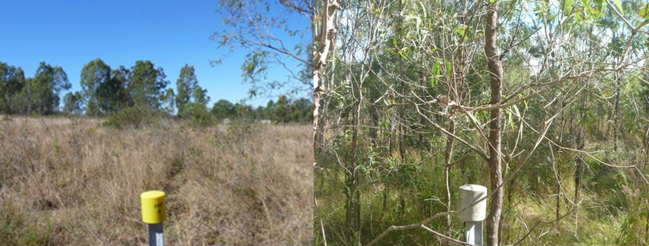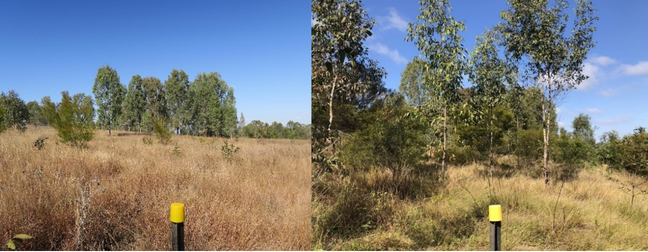Ecological Restoration Project Halfway Milestone of 10 Plan
The Balaam Hills Offset site is an approximately 18.3 hectares and is located within the Lockyer Valley Regional Council area. Ecosure began restoration works site in August 2013. The majority of the site had been historically cleared however small patches of remnant and some regrowth vegetation remained. Between 2014 and 2017, assisted regeneration and revegetation together with trials to facilitate recovery via deep soil ripping were carried out.
In 2017, Ecosure developed a restoration plan for the site to better direct works through assisted regeneration, additional planting, fire management and site maintenance to assist getting the site to remnant status. Remnant vegetation or bushland can be defined as those patches of native trees, shrubs and grasses still left. Since 2018m, over 700 hours on ground have delivered a further 6,830 trees and shrubs planted inside fenced areas to assist establishment. The fences have now been removed, and regular weed control maintenance together with BioCondition monitoring and regular reporting is carried out.
We are now halfway through implementing the plan with 5 years to go and the site is recovering well in all areas. Many native species continue to be observed germinating including Brisbane wattle (Acacia fimbriata), hickory wattle (Acacia disparrima), red ash (Alphitonia excelsa), spotted gum (Corymbia citriodora subsp. variegata), Moreton Bay ash (Corymbia tessellaris), narrow leaved ironbark (Eucalyptus crebra), silver leaved ironbark (Eucalyptus melanophloia), Queensland blue gum (Eucalyptus tereticornis), slug herb (Murdannia graminea), quinine bush (Petalostigma pubescens), blue flax lily (Dianella caerulea), native violet (Viola hederacea), native peach (Trema tomentosa) and a range of native herbs and grasses.
An increase in the diversity of fauna has also been regularly observed across the site including grey kangaroo, pretty faced wallaby, echidna, koalas with their young, and a diversity of birds including those using the developing plantings as habitat. This is especially encouraging considering the majority of the site had been cleared historically prior to restoration works beginning in 2013. With 5 more years to go, there is plenty left to do to further encourage the recovery of this now dynamic site.


